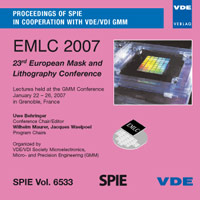Masks for Flash Memory Gates for the 45nm node: Binary or attenuated?
Conference: EMLC 2007 - 23rd European Mask and Lithography Conference
01/22/2007 - 01/26/2007 at Grenoble, France
Proceedings: EMLC 2007
Pages: 12Language: englishTyp: PDF
Personal VDE Members are entitled to a 10% discount on this title
Authors:
Setten, Eelco van; Engelen, Andre; Finders, Jo (ASML Netherlands B.V., De Run 6501, 5504 DR Veldhoven, The Netherlands)
Dusa, Mircea (ASML US Inc., 4800 Great America Parkway – Suite 500, Santa Clara, CA 95054, USA)
Abstract:
The introduction of the XT:1700Fi has brought the 45nm node well within reach for memory makers. Simulations have shown that at these small feature sizes attenuated phase shift masks may not be optimal anymore: binary intensity masks show a reduced MEEF for dense lines ans spaces using dipole illumination in combination with TE-polarization. The increased angle of incidence of the light falling on the mask causes all kinds of 3D effects that could be largely neglected up till now. Both binary and attenuated phase shift masks start to behave differently than can be expected based on scalar diffraction theory (thin-mask approach). These differences lead to some interesting observations, which make it imperative to include mask absorber material explicitly when optimizing imaging performance for the 45nm node. Flash Memory Gate structures contain both 1:1 dense lines and large semi-isolated lines. In this paper, experimental results will be shown comparing binary intensity masks with 6% attenuated phase shift masks for 1-D L/S gratings and NAND-type flash memory structures. The various imaging relevant parameters (process window, MEEF, EL, DOF and pattern placement) will be addressed and compared to simulations.


